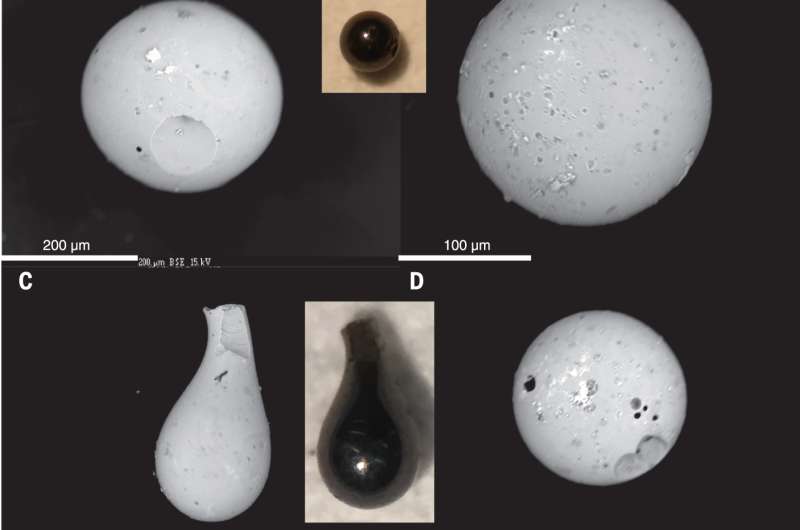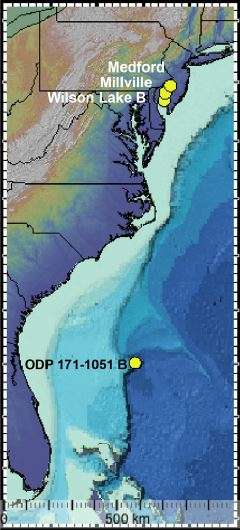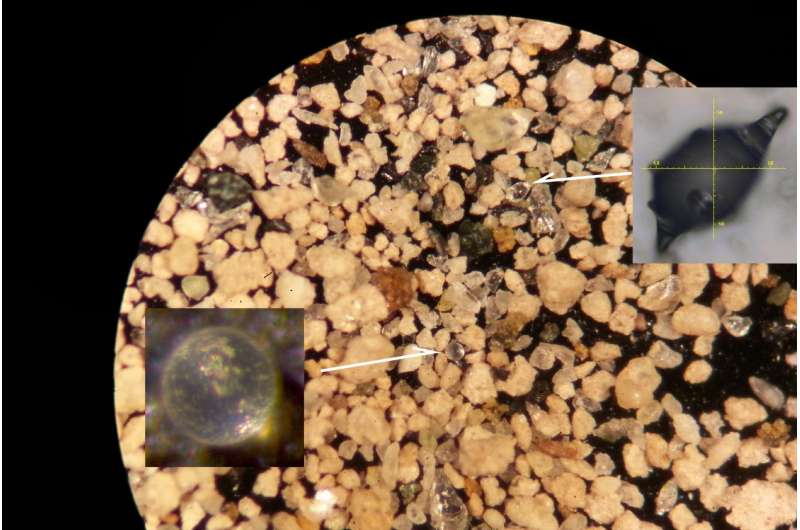Electron backscatter (15 kV) images of representative P-E spherules from Hole 1051B, Wilson Lake B, and Millville cores and the Medford exposure. Credit: M.F. Schaller et al., Science (2016)
In a new study, scientists say they have found evidence along the New Jersey coast that an extraterrestrial object hit the earth at the same time a mysterious release of carbon dioxide suddenly warmed the planet, some 55.6 million years ago. The warm period, known as the Paleocene-Eocene Thermal Maximum (PETM), is often cited as the closest analog to today's rapid human-induced climate change. The study does not explicitly say that an impact triggered the PETM, but the implication is consistent with the authors' previous work suggesting such an abrupt trigger. By contrast, mainstream theory says that the carbon came from volcanism or some other earthly cause, over thousands of years.
"This could very well be the ground zero" of the PETM, said coauthor Dennis Kent, a researcher at Columbia University's Lamont-Doherty Earth Observatory and Rutgers University. "It got warm in a hurry. This suggests where it came from." It was Kent who first suggested in a 2003 study that a comet triggered the PETM. He based his argument on magnetized clay particles found in New Jersey that he said could have been altered by a comet. Many colleagues quickly rejected the hypothesis.
The new study, published today in the leading journal Science, offers additional evidence: tiny spherical droplets of glass called microtektites. These are thought to form when an extraterrestrial object hits the Earth and sprays out vaporized material that solidifies while flying through the air. The study's lead author, geochemist Morgan Schaller of Rensselaer Polytechnic Institute, and his student Megan Fung spotted the sand-grain-size spherules at the base of a layer of fine clay believed to mark the start of the PETM. The samples came from drill cores taken in suburban Millville and Wilson Lake, N.J., and from a streambank in nearby Medford, N.J. The 30-foot-thick section of fine material, known as the Marlboro clay, is found in several areas along the U.S. East Coast, and appears to have been laid down rapidly. All the microtektites came from a seven- or eight-inch layer at its base. A fourth sample, correlated to the same time, came from a deep-seabed core taken off Bermuda.
"It's got to be more than coincidental that there's an impact right at the same time," said Schaller. "If the impact was related, it suggests the carbon release was fast."
Researchers have found apparent remnants of an extraterrestrial impact some 55 million years ago, in cores from three locations in southern New Jersey, and in a deep-seabed core off Bermuda. They say it is possible the impact kicked off a warm period often cited as the closest analog to today's rapid human-induced global warming. Credit: Schaller et al., Science, 2016
Most scientists say that the carbon release at the start of the PETM took anywhere from 5,000 to 20,000 years. Many suspect it came from a surge of massive volcanism. The resultant warming may have been abetted by a sudden release of frozen methane from the seafloor, due to warming from the carbon, changes in the earth's orbit or shifts in ocean circulation. Temperatures ascended 5 to 9 degrees Centigrade (about 9 to 16 Fahrenheit), during a nearly simultaneous warm period that lasted some 200,000 years. The planet was essentially ice free, and sea levels drastically higher than now. Many small, single-celled ocean-bottom creatures went extinct, but on the surface, many species seem to have adapted by moving poleward. Mammals, including primates, rapidly evolved. "It was almost a happy time for some, but of course there were winners and losers," observed Kent.
Many scientists suggest that human carbon emissions are now far outpacing anything that took place during the PETM. The consequences might be more drastic, because many life forms will not have time to evolve or move, they say. Earlier this year, a study led by Richard Zeebe of the University of Hawaii asserted that humans are now pumping carbon into the atmosphere 10 times faster than whatever natural forces drove the PETM.
In 2013 Schaller and James Wright of Rutgers University (also a coauthor of the new paper) published a study asserting that the PETM carbon release was virtually instantaneous. Their evidence: extremely high levels of carbon isotopes that appear in a narrow band of the Marlboro clay representing just about a dozen years. This band, it turns out, is near the newly found impact ejecta layer.
Kent said there are various scenarios about how an extraterrestrial impact might have operated. A comet would bring its own load of carbon into the atmosphere; the impact may also have vaporized carbon-rich sediments stored below the earth's surface. But those events alone might not account for the magnitude of the carbon increase and warming. In line with existing theory, Kent says the impact also could have shaken loose frozen methane from the seabed, or helped waken massive volcanism. "It's an event with a lot of consequences that would have unfolded in various aspects over seconds, minutes, hours, months and years," he said.
Microtektites as first seen in a sediment sample from the onset of the Paeocene-Eocene Thermal Maximum. Credit: Rensselaer Polytechnic Institute
The authors admit that they have not located a crater. "It could have been next door, or it could have been on the other side of the planet," said Schaller. The spherules are thinly spread, he said, which suggests the impact was large but far away, or close, but relatively small.
Charles Langmuir, a prominent paleoclimate researcher at Harvard University who was not involved in the study, said the evidence of an impact at or near the PETM boundary was "very strong." However, he said, the study does not address what caused the carbon release, nor how long it took.
Christian Koeberl, an impact specialist at the University of Vienna, said the paper could indicate such an impact, but that the spherules could have come from another time and been reworked into the PETM sediments. He pointed out that the researchers did not directly establish the spherules' age using radiometric dating—an omission that other critics also noted. An impact thought to have contributed to the extinction of dinosaurs took place off what is now Mexico's Yucatan Peninsula about 11 million years before the PETM. And, 20 million years after the PETM, a much closer impact dug out much of what is now Chesapeake Bay.
Gerald Dickens, a marine geologist at Rice University who studies the PETM, says the new paper does not "really explain anything." There are "multiple arguments for why the carbon input took thousands of years," he said. "Finding a few spherules does not change this."
Langmuir said the study is unlikely to change anyone's view of what the PETM might teach us about our own time. "From the point of view of the Earth system, a week vs. a century does not make that much difference," he wrote in an email. "Both are almost geologically instantaneous. Whether it is an impact, or huge volcanic eruptions, or human emissions, rapid changes to the atmosphere have a major impact on planetary systems, and particularly on life."
More information: "Impact ejecta at the Paleocene-Eocene boundary," Science, science.sciencemag.org/cgi/doi … 1126/science.aaf5466
Journal information: Science
Provided by Columbia University


























